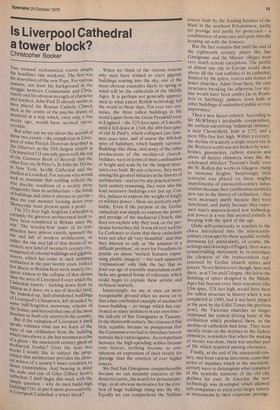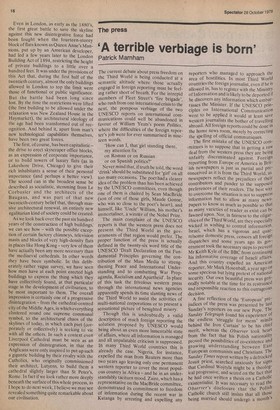Is Liverpool Cathedral a tower block?
Christopher Booker
Two unusual ecclesiastical events caught the headlines last weekend. The first was the investiture of the new Pope. For various reasobs, not least his background in the struggle between Communism and Christianity and his obvious strength of character and intellect, John Paul II already seems to have placed the Roman Catholic Church back at the centre of the psychic drama of mankind in a way which, even only a few weeks ago, wouldhave seemed inconceivable.
But what can we say about the second of these two events the completion in Liverpool of what Patrick Donovan described in the Observer as the fifth largest church in Christendom? (I can only guess with the aid of the Guinness Book of Records that the Other four are St Peter's, StJohn the Divine in New York, Seville Cathedral and the basilica at Lourdes). For anyone who would seek to maintain that nothing reflects the true psychic condition of a society more eloquently than its architecture the kinds of buildings and cities it chooses to put UP-. then the vast monster looking down over Merseyside must present quite a poser. The 331-foot high Anglican Cathedral is certainly the greatest architectural freak to have been completed in Britain since the war. The seventy-four years of its construction have almost exactly spanned the rise and fall of modern architecture, or rather the rise and fall of that dream of an entirely new kind of twentieth century city, Composed of colossal buildings and gigantic towers, which has come to such unhappy realisation in the past twenty years. Indeed few places in Britain bear more mutely eloquent witness to the collapse of that dream than the area of Liverpool 8 over which the Cathedral towers looking down from its hilltop as it does, on a sea of derelict land, the boarded-up, half-abandoned buildings of Liverpool's Chinatown, left stranded by some half-forgotten motorway scheme of the Sixties, and beyond that one of the most desolate re-built city centres in the country. But if the ruination of Liverpool 8 itself Speaks volumes what can we learn of the state of our civilisation from the building Which rises above it, the last monstrous echo of a ghost the nineteenth century ghost of Mediaeval Gothic? Over the next two Weeks I would like to subject the proposition that architecture provides the clearest mirror of a society's inner condition to Closer examination. And bearing in mind the scale and size of Giles Gilbert Scott's Cathedral, I shall begin this week with the .simple question why do men build high buildings? Or, to put it more provocatively, IS Liverpool Cathedral a tower block? When we think of the various reasons why men have wished to erect gigantic buildings soaring into the sky, one of the most obvious examples likely to spring to mind will be the cathedrals of the Middle Ages. It is perhaps not generally appreciated to what extent British technology led the world in those days. For over two centuries, the three tallest buildings in the world (apart from the Great Pyramid) were in England the 525-foot spire of Lincoln, until it fell down in 1548, the 489-foot spire of old St Paul's, which collapsed just fourteen years later, and of course the 404-foot spire of Salisbury, which happily survives. Buildings like these, and many of the other productions of the mediaeval church builders, were in terms of their combination of height and scale by far the largest structures ever built. By any criterion, they were among the greatest miracles in the history of architecture and yet by any practical twentieth century reasoning, they were also the least necessary buildings ever put up. Castles, palaces to express the weight of kingly or military power these are perfectly explicable. Even if the purpose of the Gothic cathedrals was simply to express the power and prestige of the mediaeval Church, this does not explain why they took on the particular forms they did. It was all very well for Le Corbusier to claim that these cathedrals were not after all 'very beautiful', and that they interest us only as 'the solution of a difficult problem', or even for Freudians to prattle on about 'vertical features expressing phallic imagery' but such apparent 'explanations' only hide the fact that au fond our age of scientific materialism really lacks any general frame of reference which could begin to explain these artistic and technical marvels.
Interestingly, we are at once on more recognisable ground when we move on to that other celebrated example of mediaeval tower-building an image which has captivated so many architects in our own time the hill-city of San Gimignano in Tuscany. In the thirteenth century, the citizens of this little republic became so prosperous that the Commune even had to introduce laws to restrain their extravagance. As competition between the high-spending nobles became ever fiercer, nothing became so con spicuous an expression of their rivalry for prestige than the erection of ever higher towers.
We find San Gimignano comprehensible because we can instantly conceive of the desire to outvie, the search for personal prestige, as an obvious motivation for the erec tion of huge buildings rising into the sky. Equally we can comprehend the Nyklian towers built by the feuding families of the Mani in the southern Peloponnese, partly for prestige and partly for protection a combination of arms race and quite literally keeping up with the Joneses. But the fact remains that until the end of the eighteenth century, places like San Gimignano and the Maniot villages were very much remote exceptions. The profile of almost any city in Europe would show above all the vast outlines of its cathedral, flanked by the spires, towers and domes of lesser churches. Apart from these, the only structures breaking the otherwise low skyline would have been castles (as in Bratislava or Salzburg), palaces, town halls or other buildings of undoubted public or civic importance.
Then a new factor entered. According to Mr McWhirter's invaluable compendium, the earliest surviViving 'industrial chimney' is near Chesterfield, built in 1771 and a mere fifty-five feet high. Within a century, the skyline of scarcely a single major city in the Western world was not broken by warehouses, gasometers, railway stations and above all factory chimneys, some like the celebrated 400-foot 'Tennant's Stalk' over the St. Rollox dye works in Glasgow, rising to immense heights. Surprisingly little restraint was placed on these mighty impedimenta of nineteenth-century indus trialism because their justification seemed a new one in the history of civilisation they were necessary partly because they were functional, and partly because they expressed man's unprecedented new technological power in a way that seemed entirely in keeping with the spirit of the age.
Quite self-consciously in reaction to the chaos introduced into the nineteenth century cityscapes by these squalid, worldly intrusions (cf. particularly, of course, the writings and drawings of Pugin), there was a countervailing movement to re-introduce the element of the transcendent represented by Gothic church spires and towers. Nevertheless even though, here and there, as at Ulm and Cologne, this led to the finishing of spires designed in the Middle Ages but beyond even their resources (the Ulm spire, 528 feet high, would have been the tallest structure in history when it was completed in 1890, had it not been pipped at the post by the Eiffel Tower the previous year), the Victorian churches no longer expressed the central driving force of the civilisation which produced them, as the mediaeval cathedrals had done. They were merely rivals on the skylines to the factory chimneys, reminders that when the making of money was done, there was another part of life which required passing obeisance.
Finally, at the end of the nineteenth century, and from various directions, came that series of impulses which in the twentieth century were to disintegrate what remained of the symbolic harmony of the old city skylines for ever. In America, the new technology was developed which allowed rich companies to erect ever-larger towers as monuments to their corporate prestige. Even in London, as early as the 1880's, the first great battle to save the skyline against this new disintegrative force had been fought when the fourteen-storey block of flats known as Queen Anne's Mansions, put up by an American developer, had led a few years later to the London Building Act of 1894, restricting the height of private buildings to a little over a hundred feet. It was under the provisions of this Act that, during the first half of the twentieth century, almost the only buildings allowed in London to top the limit were those of functional or public significance. But the battle had been long since lost. By the time the restrictions were lifted (the first building to be allowed under the relaxation was New Zealand House in the Haymarket), the architectural ideology of the age had been transformed out of recognition. And behind it, apart from man's new technological capabilities themselves, have been two great forces.
The first, of course, has been capitalistic— the drive to erect skyscraper office blocks, as an expression of corporate importance, or to build towers of luxury flats (as in Lakeshore Drive, Chicago) to give their rich inhabitants a sense of their personal importance (and perhaps a better view). The second can in the broadest sense be described as socialistic, stemming from Le Corbusier and the architects of the Baugaus, and was part of that new twentieth-century belief that, through massive architectural renewal, an entirely new egalitarian kind of society could be created.
As we look back over the past six hundred years of the construction of high buildings,' we can see how — with the possible exception of certain factory chimneys, television masts and blocks of very high-density flats in places like Hong Kong— very few of them have actually been any more necessary than the mediaeval cathedrals. In other words they have been symbolic. In this deliberately rather vague survey, we have seen how men have at each point erected high buildings to express the thing which they have collectively found, at that particular stage in the development of civilisation, to be most important to them. The overall impression is certainly one of a progressive disintegration from the cathedral-centred city of the Middle Ages, in which everything clustered round one supreme communal symbol, to the architectural chaos of the skylines of today, in which each part (corporately or collectively) is seeking to vie with all the others. In such a context even Liverpool Cathedral must be seen as an expression of disintegration, in that the Anglicans were only inspired to put up such a gigantic building by their rivalry with the Catholics, who originally commissioned their architect, Lutyens, to build them a cathedral slightly larger than St Peter's, Rome. In fact if we look rather more deeply beneath the surface of this whole process, as I hope to do next week, I believe we may see revealed something quite remarkable about our civilisation.







































 Previous page
Previous page